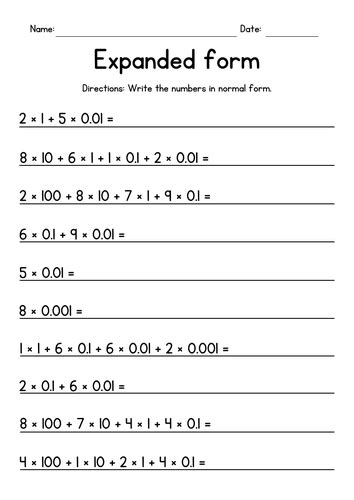Expanded form decimals are a fundamental concept in mathematics, and mastering them is crucial for success in various math-related subjects. In this article, we will delve into the world of expanded form decimals, exploring their definition, importance, and practical applications. We will also provide a comprehensive worksheet to help you practice and reinforce your understanding of this essential math concept.
What are Expanded Form Decimals?
Expanded form decimals are a way of expressing decimal numbers in a more detailed and expanded format. This format shows the value of each digit in the decimal number, making it easier to understand and work with. For example, the decimal number 4.25 can be written in expanded form as 4 + 0.2 + 0.05. This format helps to break down the decimal number into its constituent parts, making it easier to perform arithmetic operations and calculations.

Why are Expanded Form Decimals Important?
Expanded form decimals are essential in mathematics because they provide a deeper understanding of decimal numbers and their properties. By breaking down decimal numbers into their expanded form, you can:
- Better understand the concept of place value and how it applies to decimal numbers
- Perform arithmetic operations, such as addition and subtraction, with greater accuracy and ease
- Compare and order decimal numbers with greater precision
- Develop a stronger foundation for more advanced math concepts, such as algebra and geometry
How to Write Decimal Numbers in Expanded Form
Writing decimal numbers in expanded form is a straightforward process that involves breaking down the number into its constituent parts. Here are the steps:
- Identify the decimal number you want to write in expanded form.
- Separate the whole number part from the decimal part.
- Break down the decimal part into its constituent parts, using the place value of each digit.
- Write the expanded form of the decimal number, using the whole number part and the broken-down decimal part.
For example, the decimal number 3.45 can be written in expanded form as:
3 + 0.4 + 0.05
Expanded Form Decimals Worksheet
Here is a comprehensive worksheet to help you practice and reinforce your understanding of expanded form decimals:
Section 1: Writing Decimal Numbers in Expanded Form
- Write the decimal number 2.75 in expanded form.
- Write the decimal number 4.92 in expanded form.
- Write the decimal number 1.35 in expanded form.
- Write the decimal number 3.18 in expanded form.
- Write the decimal number 2.49 in expanded form.
Section 2: Identifying Equivalent Decimal Numbers
-
Which of the following decimal numbers is equivalent to 3.45? a) 3 + 0.4 + 0.05 b) 3 + 0.45 + 0.005 c) 3 + 0.4 + 0.05 + 0.001 d) 3 + 0.45 + 0.005 + 0.001
-
Which of the following decimal numbers is equivalent to 2.75? a) 2 + 0.7 + 0.05 b) 2 + 0.75 + 0.005 c) 2 + 0.7 + 0.05 + 0.001 d) 2 + 0.75 + 0.005 + 0.001
Section 3: Comparing Decimal Numbers
- Compare the decimal numbers 3.45 and 3.42. Which one is greater?
- Compare the decimal numbers 2.75 and 2.72. Which one is greater?
- Compare the decimal numbers 1.35 and 1.32. Which one is greater?
- Compare the decimal numbers 4.92 and 4.89. Which one is greater?
- Compare the decimal numbers 2.49 and 2.45. Which one is greater?
Section 4: Ordering Decimal Numbers
- Order the decimal numbers 3.45, 3.42, and 3.38 from least to greatest.
- Order the decimal numbers 2.75, 2.72, and 2.69 from least to greatest.
- Order the decimal numbers 1.35, 1.32, and 1.29 from least to greatest.
- Order the decimal numbers 4.92, 4.89, and 4.85 from least to greatest.
- Order the decimal numbers 2.49, 2.45, and 2.41 from least to greatest.
Conclusion
Mastering expanded form decimals is a crucial step in developing a strong foundation in mathematics. By understanding how to write decimal numbers in expanded form, you can perform arithmetic operations with greater accuracy and ease, compare and order decimal numbers with greater precision, and develop a stronger foundation for more advanced math concepts. We hope this worksheet has helped you practice and reinforce your understanding of expanded form decimals.
What is the purpose of writing decimal numbers in expanded form?
+The purpose of writing decimal numbers in expanded form is to provide a deeper understanding of the decimal number and its properties, making it easier to perform arithmetic operations and calculations.
How do I write a decimal number in expanded form?
+To write a decimal number in expanded form, separate the whole number part from the decimal part, break down the decimal part into its constituent parts using the place value of each digit, and write the expanded form of the decimal number using the whole number part and the broken-down decimal part.
Why is it important to compare and order decimal numbers?
+Comparing and ordering decimal numbers is important because it helps to determine which number is greater or lesser, making it easier to perform arithmetic operations and calculations.
